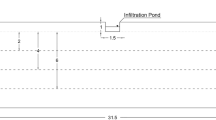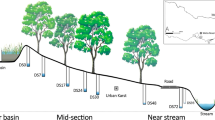Abstract
Infiltration basins are increasingly used worldwide to both mitigate flood risk in urban areas and artificially recharge shallow aquifers. Understanding recharge dynamics controlling the quantity and quality of infiltrating water is required to correctly design and maintain these facilities. In this paper, we focus on quantitative aspects and analyze in detail the temporal evolution of infiltration rates in basins overlying highly permeable aquifers. In these settings, recharge is a complex process due to high recharge rate and volume, undetected soil hydraulic heterogeneity and topsoil clogging. A 16-ha infiltration basin in Northern Italy has been intensively characterized and monitored for over four years. Field and laboratory tests were performed to characterize soil hydraulic properties. An unsaturated-saturated numerical model was implemented to obtain additional quantitative information supporting experimental data. Results show a strong impact of the infiltration basin on natural recharge patterns. When properly maintained (no clogging of topsoil), estimated infiltration rates from the bottom of the basin are about fifty times higher than recharge under natural conditions in the same area. When the infiltration basin is not properly maintained, bioclogging progressively diminishes the infiltration capacity of the basin, which turns to have no impact on aquifer recharge. Recharge patterns are highly erratic and difficult to predict. We observed natural recharge rates of the order of 1 m/h and a poor correlation between recharge times and maximum intensity of rainfall events. Due to the complex behavior of the recharge, the numerical model (based on the classical Richards equation) is able to explain many but not all the observed recharge events. Macropores flow and Lisse effects on piezometric measurements may be responsible for the disagreement between model predictions and observations.







Similar content being viewed by others
References
ASTM (2006) Test Method for Permeability of Granular Soils (Constant Head). Tech. rep., ASTM International, D18 Committee
Barahona-Palomo M, Pedretti D, Sanchez-Vila X (2010) Infiltration tests at the Sant Vicen cc dels Horts artificial recharge experimental site. In: 2010 EGA (ed) Geophysical Research Abstracts, EGU2010-5326, vol 12
Baveye P, Vandevivere P, Hoyle BL, Leo PCd, Lozada-Sanchez Dd (1998) Environmental impact and mechanisms of the biological clogging of saturated soils and aquifer materials. Critical Rev Environ Sci Tech 28(2):123–191. doi:10.1080/10643389891254197
Beven K, Germann P (2013) Macropores and water flow in soils revisited. Water Resour Res 49(6):3071–3092. doi:10.1002/wrcr.20156
Bobba AG (2012) Ground Water-Surface Water Interface (GWSWI) modeling: Recent advances and future challenges. Water Resour Manag 26(14):4105–4131. doi:10.1007/s11269-012-0134-x
Bouwer H (2002) Artificial recharge of groundwater: hydrogeology and engineering. Hydrogeol J. doi:10.1007/s10040-001-0182-4
Browne D, Deletic A, Mudd GM, Fletcher TD (2008) A new saturated/unsaturated model for stormwater infiltration systems. Hydrol Process 22 (25):4838–4849. doi:10.1002/hyp.7100
Ching-Chuan H, Yih-Jang J, Lih-Kang H, Jin-Long L (2009) Internal soil moisture and piezometric responses to rainfall-induced shallow slope failures. J Hydrol 370(1–4):39–51. doi:10.1016/j.jhydrol.2009.02.051
Dechesne M, Barraud S, Bardin JP (2004) Indicators for hydraulic and pollution retention assessment of stormwater infiltration basins. J Environ Manag 71 (4):371–380. doi:10.1016/j.jenvman.2004.04.005
Delin GN, Healy RW, Lorenz DL, Nimmo JR (2007) Comparison of local- to regionalscale estimates of ground-water recharge in Minnesota, USA. J Hydrol 334(1–2):231–249. doi:10.1016/j.jhydrol.2006.10.010
ENI-AGIP (2002) Geologia degli acquiferi padani della Regione Lombardia. Regione Lombardia - ENI Divisione AGIP
GEO-SLOPE (2006) SEEP/W for Finite Elements Seepage Analysis Version 5 GEO-SLOPE International Ltd. Users Guide, Calgary, Alberta, Canada
Green RE, Corey JC (1971) Calculation of hydraulic conductivity: A further evaluation of some predictive methods. Soil Sci Soc Am J 35(5):3–8
Guin JA (1972) Clogging of nonuniform filter media. Ind Eng Chem Fundam 11 (3):345–349. doi:10.1021/i160043a010
Guo H, Jiao JJ, Weeks EP (2008) Rain-induced subsurface airflow and Lisse effect. Water Resour Res 44(7):W07,409. doi:10.1029/2007WR006294
Gupta SC, Larson WE (1979) Estimating soil water retention characteristics from particle size distribution, organic matter percent and bulk density. Water Resour Res 15:1633–1635
Healy RW, Cook PG (2002) Using groundwater levels to estimate recharge. Hydrogeol J 10(1):91–109. doi:10.1007/s10040-001-0178-0
Houston S, Duryea P, Hong R (1999) Infiltration considerations for ground-water recharge with waste effluent. J Irrig Drain Eng 125(5):264–272. doi:10.1061/(ASCE)0733-9437(1999)125:5(264)
Hughes CE, Binning P, Willgoose GR (1998) Characterisation of the hydrology of an estuarine wetland. J Hydrol 211(1–4):34–49. doi:10.1016/S0022-1694(98)00194-2
Kandra H, McCarthy D, Deletic A (2014) Assessment of the impact of stormwater characteristics on clogging in stormwater filters. Water Resour Manag 29 (4):1031–1048. doi:10.1007/s11269-014-0858-x
Kim J, Jeong S, Park S, Sharma J (2004) Influence of rainfall-induced wetting on the stability of slopes in weathered soils. Eng Geol 75(34):251–262. doi:10.1016/j.enggeo.2004.06.017
Langhans C, Govers G, Diels J, Leys A, Clymans W, AVd Putte, Valckx J (2011) Experimental rainfall-runoff data: Reconsidering the concept of infiltration capacity. J Hydrol 399(3-4):255–262. doi:10.1016/j.jhydrol.2011.01.005
Manghi F, Williams D, Safely J, Hamdi MR (2011) Groundwater flow modeling of the arlington basin to evaluate management strategies for expansion of the arlington desalter water production. Water Resour Manag 26(1):21–41. doi:10.1007/s11269-011-9899-6
Manglik A, Rai SN (2014) Modeling water table fluctuations in anisotropic unconfined aquifer due to time varying recharge from multiple heterogeneous basins and pumping from multiple wells. Water Resour Manag 29(4):1019–1030. doi:10.1007/s11269-014-0857-y
Masetti M, Diolaiuti G, D’Agata C, Smiraglia C (2010) Hydrological characterization of an ice-contact lake: Miage Lake (Monte Bianco, Italy). Water Resour Manag 24(8):1677–1696. doi:10.1007/s11269-009-9519-x
Mondal NC, Singh VP, Ahmed S (2012) Entropy-based approach for assessing natural recharge in unconfined aquifers from Southern India. Water Resour Manag 26 (9):2715–2732. doi:10.1007/s11269-012-0042-0
Morbidelli R, Corradini C, Saltalippi C, Brocca L (2012) Initial soil water content as input to field-scale infiltration and surface Runoff models. Water Resour Manag 26(7):1793–1807. doi:10.1007/s11269-012-9986-3
Motha JA, Wigham JM (1995) Modelling overland flow with seepage. J Hydrol 169(1–4):265–280. doi:10.1016/0022-1694(94)02611-E
Okubo T, Matsumoto J (1979) Effect of infiltration rate on biological clogging and water quality changes during artificial recharge. Water Resour Res 15(6):1536
Pedretti D, Masetti M, Marangoni T, Beretta GP (2011) Slurry wall containment performance: monitoring and modeling of unsaturated and saturated flow. Environ Monit Assess 184(2):607–624. doi:10.1007/s10661-011-1990-1
Pedretti D, Barahona-Palomo M, Bolster D, Fernndez-Garcia D, Sanchez-Vila X, Tartakovsky DM (2012) Probabilistic analysis of maintenance and operation of artificial recharge ponds. Adv Water Resour 36:23–35. doi:10.1016/j.advwatres.2011.07.008
Perez-Paricio A, Carrera J (1999) Clogging handbook. Tech rep., Final report, EU project on Artificial Recharge of Groundwater
Pitt R, Clark S, Field R (1999) Groundwater contamination potential from stormwater infiltration practices. Urban Water 1(3):217–236. doi:10.1016/S1462-0758(99)00014-X
Regione Lombardia (2011) Technical Guidelines fort for the design and maintenance of facilities for land protection and management (in Italian). http://www.territorio.regione.lombardia.it
Scanlon B, Cook P (2002) Theme issue on groundwater recharge. Hydrogeol J 10(1):3–4
Smith RE (1972) The infiltration envelope: results from a theoretical infiltrometer. J Hydrol 17:1–21
Stafford N, Che D, Mays LW (2015) Optimization model for the design of infiltration basins. Water Resour Manag 29(8):2789–2804. doi:10.1007/s11269-015-0970-6
Tsaparas I, Rahardjo H, Toll DG, Leong EC (2002) Controlling parameters for rainfall-induced landslides. Comput Geotech 29(1):1–27. doi:10.1016/S0266-352X(01)00019-2
Weeks EP (2002) The Lisse effect revisited. Ground Water 40(6):652–656. doi:10.1111/j.1745-6584.2002.tb02552.x
Yen H, Jeong J, Feng Q, Deb D (2014) Assessment of input uncertainty in swat using latent variables. Water Resour Manag 29(4):1137–1153. doi:10.1007/s11269-014-0865-y
Acknowledgments
The Authors would like to gratefully thank Lamont Research Professor Leonardo Seeber, of Columbia Universitys Lamont-Doherty Earth Observatory, for his valuable comments and suggestions that helped to greatly improve our article. Thanks also to Prof. Giovanna della Porta, of Università degli Studi di Milano, for providing the image of Fig. 2b. A.S. is currently supported by funding from the Bill & Melinda Gates Foundation (OPP1106427, 1032350) in the framework of the WorldPop Project (www.worldpop.org) and was affiliated with the Dipartimento di Scienze della Terra ’A. Desio’, Universit`a degli Studi di Milano when this study began. This study was partly funded by the Istituto Regionale di Ricerca della Lombardia (IReR 2008B053, 2009B002). The funders had no role in study design, data collection and analysis, decision to publish, and preparation of the manuscript.
Conflict of Interest
No conflict of interest.
Author information
Authors and Affiliations
Corresponding author
Rights and permissions
About this article
Cite this article
Masetti, M., Pedretti, D., Sorichetta, A. et al. Impact of a Storm-Water Infiltration Basin on the Recharge Dynamics in a Highly Permeable Aquifer. Water Resour Manage 30, 149–165 (2016). https://doi.org/10.1007/s11269-015-1151-3
Received:
Accepted:
Published:
Issue Date:
DOI: https://doi.org/10.1007/s11269-015-1151-3




